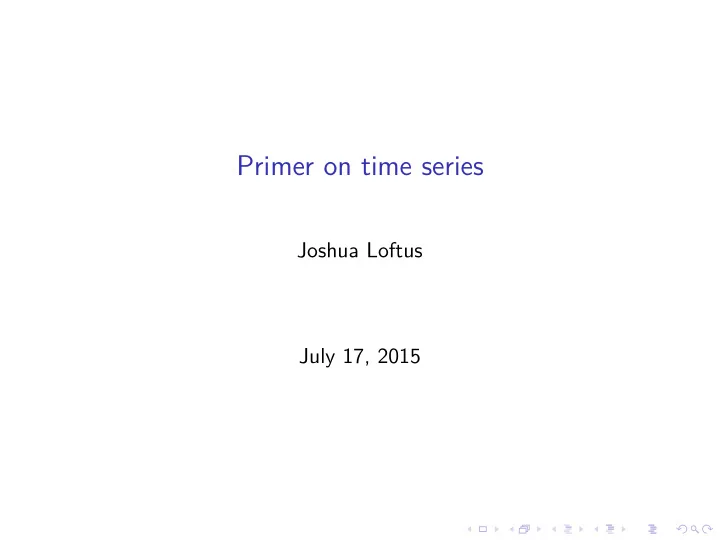

Primer on time series Joshua Loftus July 17, 2015
Outline ◮ Motivating examples ◮ A spoonful of theory ◮ Further reading
ts(): Creating a time series object Google trends: search popularity of “game of thrones” Read the data and subset to the right part (the .csv file from Google trends is a bit messy) setwd ("~/Dropbox/work/teaching/consulting/timeseries") data <- read.csv ("GoT.csv", skip = 4, stringsAsFactors = F) data <- data[1:211,] data[,2] <- as.numeric (data[,2]) The data is given by week. Seasons happen once per year. d <- ts (data[,2], frequency = 52)
stl(): Seasonal decomposition by Loess fit <- stl ( log (d), s.window = "period") plot (fit) 4.5 3.5 data 2.5 1.5 1.0 seasonal 0.5 0.0 −0.5 3.0 2.8 trend 2.6 2.4 2.2 0.6 remainder 0.2 −0.2 −0.6 1 2 3 4 5 time
library(forecast): Predicting the future plot ( forecast (fit)) Forecasts from STL + ETS(A,N,N) 5 4 3 2 1 2 3 4 5 6 7
Discontinuity and “causal” inference ◮ Time series observed before and after an intervention ◮ If behavior changes dramatically, maybe it was because of the intervention ◮ Important to rule out other things happening at that time ◮ Example next slide: search popularity of “Star Wars” before and after Disney purchase announced
library(CausalImpact) developed at Google impact <- CausalImpact ( as.numeric (data[,2]), pre.period, post.period) plot (impact) 100 75 original 50 25 0 75 50 pointwise 25 0 750 cumulative 500 250 0 0 100 200
Stochastic processes ◮ { X t } t ≥ t 0 ◮ Collection of random variables indexed by time t , in practice discrete ◮ Most methods require stationarity : ( X t 1 , . . . , X t k ) has same distribution as ( X t 1 + h , . . . , X t k + h ) ◮ Transform data by taking logs, differences, to get stationarity ◮ Many classes of models. . .
Moving averages and autoregression ◮ MA(q) moving average: X t = µ + ǫ t + θ 1 ǫ t − 1 + · · · + θ q ǫ t − q ◮ Random shock affects future values of X directly ◮ AR(p) autoregression: X t = c + φ 1 X t − 1 + · · · + φ p X t − p + ǫ t ◮ Random shock affects future values of X only through past values of X ◮ AMRA(p,q) autoregessive moving-average ◮ ARIMA. . .
Error terms ◮ ARCH conditional heteroskedasticity: variance of present error depends on observed past errors ◮ GARCH generalized: also depends on variance of past errors ◮ e.g. ARIMA/GARCH together quite general (5 parameters)
Further introductory reading Very short reference http://www.statmethods.net/advstats/timeseries.html Short, easy tutorial, start in chapter 2 http://www.statoek.wiso.uni-goettingen.de/ veranstaltungen/zeitreihen/sommer03/ts_r_intro.pdf Another similar tutorial (I prefer the one above) https://a-little-book-of-r-for-time-series. readthedocs.org/en/latest/src/timeseries.html A Bayesian approach like “interrupted time series” (developed at Google) http://www.r-bloggers.com/ causalimpact-a-new-open-source-package-for-estimating-causal- Hidden Markov models (application in genetics) http://a-little-book-of-r-for-bioinformatics. readthedocs.org/en/latest/src/chapter10.html
Recommend
More recommend